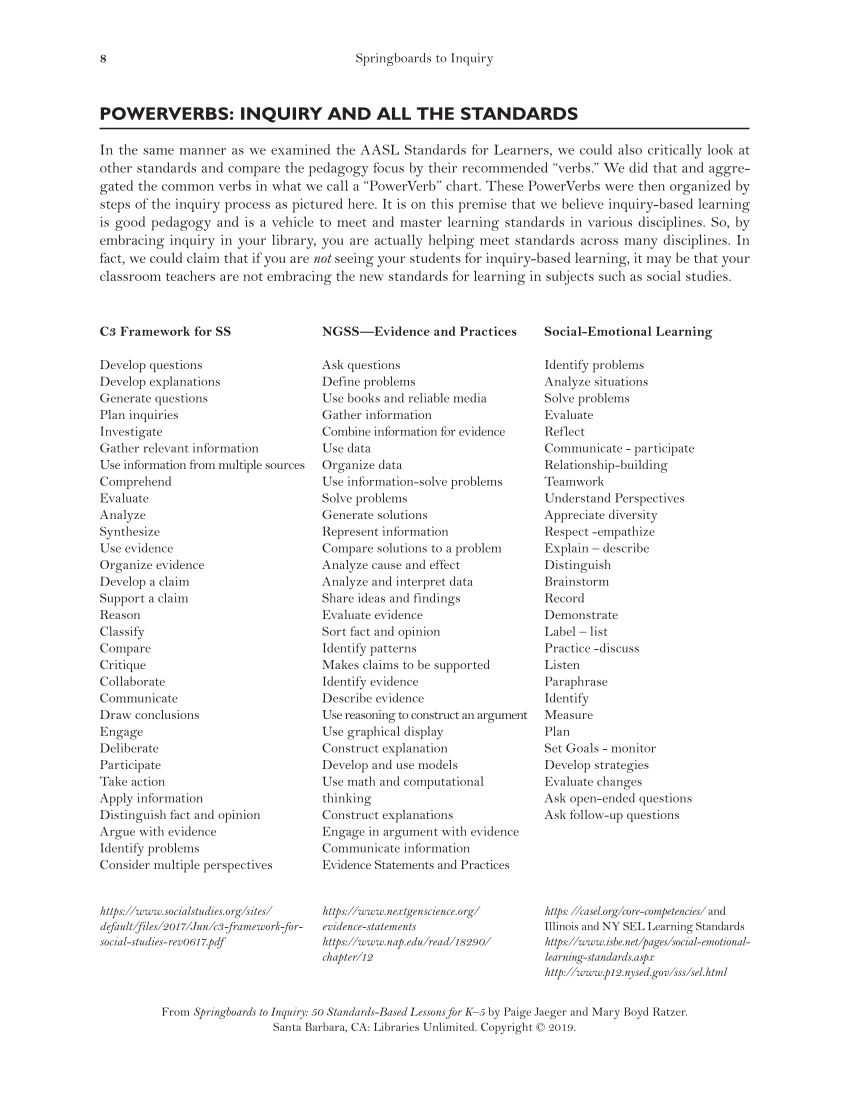8 Springboards to Inquiry POWERVERBS: INQUIRY AND ALL THE STANDARDS In the same manner as we examined the AASL Standards for Learners, we could also critically look at other standards and compare the pedagogy focus by their recommended “verbs.” We did that and aggre- gated the common verbs in what we call a “PowerVerb” chart. These PowerVerbs were then organized by steps of the inquiry process as pictured here. It is on this premise that we believe inquiry-based learning is good pedagogy and is a vehicle to meet and master learning standards in various disciplines. So, by embracing inquiry in your library, you are actually helping meet standards across many disciplines. In fact, we could claim that if you are not seeing your students for inquiry-based learning, it may be that your classroom teachers are not embracing the new standards for learning in subjects such as social studies. C3 Framework for SS Develop questions Develop explanations Generate questions Plan inquiries Investigate Gather relevant information Use information from multiple sources Comprehend Evaluate Analyze Synthesize Use evidence Organize evidence Develop a claim Support a claim Reason Classify Compare Critique Collaborate Communicate Draw conclusions Engage Deliberate Participate Take action Apply information Distinguish fact and opinion Argue with evidence Identify problems Consider multiple perspectives https://www.socialstudies.org/sites/ default/files/2017/Jun/c3-framework-for- social-studies-rev0617.pdf NGSS—Evidence and Practices Ask questions Define problems Use books and reliable media Gather information Combine information for evidence Use data Organize data Use information-solve problems Solve problems Generate solutions Represent information Compare solutions to a problem Analyze cause and effect Analyze and interpret data Share ideas and findings Evaluate evidence Sort fact and opinion Identify patterns Makes claims to be supported Identify evidence Describe evidence Use reasoning to construct an argument Use graphical display Construct explanation Develop and use models Use math and computational thinking Construct explanations Engage in argument with evidence Communicate information Evidence Statements and Practices https://www.nextgenscience.org/ evidence-statements https://www.nap.edu/read/18290/ chapter/12 Social-Emotional Learning Identify problems Analyze situations Solve problems Evaluate Reflect Communicate - participate Relationship-building Teamwork Understand Perspectives Appreciate diversity Respect -empathize Explain – describe Distinguish Brainstorm Record Demonstrate Label – list Practice -discuss Listen Paraphrase Identify Measure Plan Set Goals - monitor Develop strategies Evaluate changes Ask open-ended questions Ask follow-up questions https: //casel.org/core-competencies/ and Illinois and NY SEL Learning Standards https://www.isbe.net/pages/social-emotional- learning-standards.aspx From Springboards to Inquiry: 50 Standards-Based Lessons for K–5 by Paige Jaeger and Mary Boyd Ratzer. Santa Barbara, CA: Libraries Unlimited. Copyright © 2019. http://www.p12.nysed.gov/sss/sel.html
Document Details My Account Print multiple pages
Print
You have printed 0 times in the last 24 hours.
Your print count will reset on at .
You may print 0 more time(s) before then.
You may print a maximum of 0 pages at a time.
































































































































































